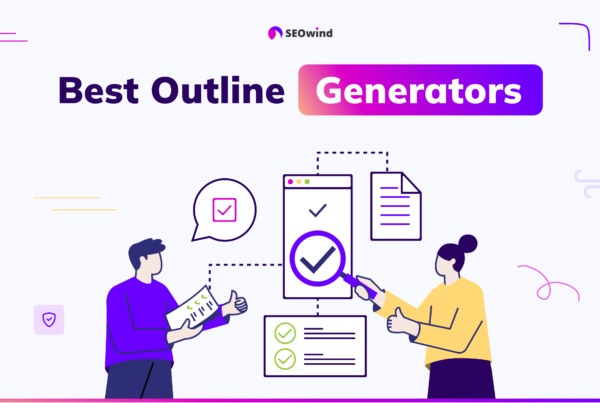Have you ever stopped to think about how blog posts are written? Most of us just publish articles whenever the need appears. But if you want to publish quality content, then you need to take your writing strategy more seriously. You need to learn how to write a blog post outline.
A blog post outline is a formula for writing blog posts that makes them easier for you and your readers to understand. It also helps organize your thoughts as you write so it doesn’t feel overwhelming when you sit down at your computer. The good news is that everyone who publishes blogs already knows this stuff, but they may not have realized that there’s a name for it or they haven’t been using a particular formula before.
Let’s dive in.
TL;DR
- A blog post outline is a skeleton for each blog post that provides a structure and topic for the post, and a way to organize your thoughts as you write.
- A blog post outline is useful for reducing stress, staying organized, and tracking progress with writing an article.
- An outline helps editors and writers get on the same page and ensure that the content meets expectations.
- You should use a blog post outline whenever you’re writing any content to have a better chance of making your content rank and delivering the value your readers are looking for.
- Outlines are particularly helpful when creating long-form posts (1,000 words or more), writing about a complex topic that requires a lot of research to accurately cover, or assigning writing a blog post to another copywriter.
- The first step in creating a blog post outline is to figure out your topic and narrow it down by asking questions like who you are writing for, what goals they want to achieve, and what equipment they might want to use.
- You can break down a larger subject into more specific aspects by asking questions like what, when, where, why, and how.
- Asking “what” questions will help you stay focused and on topic, while “who” questions will help you understand your target audience.
- Use a template for your blog post outline to make it easier to create and maintain consistency.
- The basic structure of a blog post outline includes a title, introduction, main points, sub-points, and conclusion.
What is a blog post outline?
A blog post outline is a skeleton for each blog post you write. I call it the skeleton because it doesn’t tell you how to write the actual blog post. The outline provides a structure and topic for the post, and a way to organize your thoughts as you write.
There are many different ways to write an outline, but they all have a similar structure. Your outline will be a series of headings that describe the sections of the post. Each section will be labeled with a title and an explanation. Then, you’ll include one or more bulleted subsections.
Why you should write a blog post outline
A blog post outline is useful for a few different reasons.
Blog post outline provides you with a clear structure
First, it lets you reduce stress when you sit down to write. Your outline provides a structure that helps you focus on the main point. You don’t have to worry about what comes next or where you begin or end your article. An outline also helps you stay organized as you write. Remembering where you were in your outline removes the “writing blank” feeling that some people experience.
Blog post outline helps you track progress with writing an article
You can also use your outline to track the progress you make on your article. You can see how much content you’ve already written, and you can make adjustments if you need to go back and rewrite a section.
Blog post outline gets you and your editor on the same page
It’s all about expectations. When you have a clear outline with content requirements you can be sure that the content you will provide matches the editor’s expectations. This way they will be much fewer rewrites and changes once you deliver the article draft.
When should you write a blog post outline?
The answer might surprise you. I’m a strong believer that you should use a blog post outline whenever you’re writing any content.

Why is it so?
With a clear blog post outline, you have a much better chance of making your content rank. You have a clear idea of what you’re going to write about, what topics to cover, what questions to answer, and what keywords to include. You can make sure that you’re delivering the value your readers are looking for.
Whenever you write a piece of content, an outline is almost always a good idea, but they are particularly helpful when:
- You are creating a long-form post (1,000 words or more).
- You’re writing about a complex topic that requires a lot of research to accurately cover.
- You’re assigning writing a blog post to another copywriter and you want to make sure they understand what you want the post to touch on.
Start each blog post with an outline.
Especially if you approach it in the right way and do your homework.
Proper research on what gets to top SERPs and what interests people regarding this topic.
How to create a blog post outline
A blog post outline is a structured method for documenting your ideas. The format for an outline is straightforward.
Step 1 Figure out your topic
When creating the blog post outline your first step should be to figure out the topic. Find what you want to write about. It doesn’t have to be very specific yet.
Let’s say you want to write about fitness exercises at home as you are delivering online training programs or equipment.
You could narrow down your topic by asking:
- Who am I writing for?
- What goals do they want to achieve?
- What equipment might they want to use?
- When is the best time for doing fitness?
By asking questions: what, when, where, why, and how, you can break down a larger subject into more specific aspects.

Below you’ll find the detailed list of questions that work for us whenever we want to create the most pertinent, well-organized content with the appropriate voice and tone.
Use “What” questions
What would you concentrate on if you were to sum it up in a sentence? Asking this question will help you stay focused and on topic. Overall, whatever you say should support that single statement.
- What exactly does your topic entail? (What are the topics covered in each section of your blog post?) This will assist you in gathering and organizing your thoughts for the presentation in the blog article.
- What sort of a piece is that? (For instance, a review article? A well-researched piece for education purposes?) You can improve your writing by asking this. A review-style content might be more opinionated and conversational. A research essay, on the other hand, is fact-based and might call for additional formality.
- What is the point of your writing? What do you hope to accomplish with your words? Your writing style will improve if you respond to that. Are you writing (and there can be more than one answer):
- to amuse?
- to inform and educate?
- to persuade a decision?
- to boost website traffic?
- to arouse feelings?
You should write more persuasively and “incite emotion” if, for instance, your goal is to “influence consideration” for a good or service. Then use extra adverbs to make the product sound more alluring.
If you want to gain more traffic then it might be useful to prioritize keyword optimization. Still, you don’t need to choose only one approach.
If it makes sense for your blog article, you can combine several style goals.
Use “who” questions
- Who is your audience? For whom exactly are you writing this?
Do some digging into your target demographic in terms of age, group identity, gender, interests, and preferences to acquire a solid grasp of both your audience and your prospective customers.
It is necessary to know your audience to select the appropriate writing style and to include the appropriate idioms, slang, and jargon in your writing. This way your blog post comes across as more alluring, fascinating, and pleasurable to read. When you write blog posts, you must keep your audience in mind at all times; otherwise, you run the risk of creating content that no one will find useful and enjoyable.
- Who will be negatively affected by this content? Who will benefit? Who will be damaged?
These questions will act as a helpful reminder to ensure that your content consistently provides information that is beneficial to the audiences you are targeting. In addition, considering who might be “harmed” by what you say will help you be more careful with your word choice and prevent you from making statements that might be hurtful to other stakeholders.
Use “Where?” questions
Where does your audience come from? Where do they spend their time?
Even if you are writing your blog post on a laptop in Sydney, Australia, the majority of your readers maybe be more likely based in the United Kingdom or the USA. As a result, it would be unacceptable to use idioms, slang, or cultural Australian allusions in a piece of writing whose audience is unlikely to be familiar with these types of references.
Use “Why?” questions
Why should readers bother reading what you have to say? How significant is the post you are writing for your blog? What value does it deliver?
- Make an effort to integrate the answer in your blog article so that your audience may comprehend the importance of what you have to say.
- Determine the purpose of the content and why it needs to be written in the first place.
- Remove the overused phrases that are indicative of sloppy writing. Each paragraph needs to appear engaging and deliver value.
Use “How?” questions
How does this subject function? This is an excellent question regarding the “how-tos”. Make thorough research, think over connections, analyze them, and present them in an understandable and easy-to-follow way. Take a more comprehensive approach and connect each section to a larger subject.
By using the above approach you will likely not only come up with the topic but also the main headings and subjects you want to include in your blog post.
Step 2 Identify your main keyword
Some might argue that keywords are not essential. The readers are the most important. You should indeed write your content with the reader in mind.
Still, researching for keywords is not a step you should overlook.
Too often, I see content that doesn’t perform. Usually, the main issue comes from prioritizing creativity over a thorough and well-thought-out process.
So, first things first: establish a keyword or topic that is relevant to your audience.
I look at keywords as a way of identifying what interests people. When typing in Google search, they have certain search intent in mind. They are looking for some answers to their questions, some are very specific, others general. Identifying the right keywords and queries makes you better understand your audience’s needs, and the language they use.
If you’re not an SEO expert you can investigate what top Search Engine Result Pages show, so basically what ranks on the first Google page when typing your topic. By using tools like SEMrush or ahrefs you can look through the keywords they rank and choose the one that you believe will be the best for the content you have in mind.
Pro tips for identifying main keywords:
- To find the right one, you have to check the search volume. If you are starting to build content, it might be worth looking into more specific mid or bottom-funnel keywords rather than general options.
- Keep in mind the keyword difficulty. Again, if you are just starting your content marketing adventure, then better pick up keywords with low to medium keyword difficulty.
Step 3 List headings and key takeaways
Now it’s time to go a bit deeper. Headings and key takeaways are the core of a great blog post outline. By taking the time to include them, you can save yourself time, later on, ensuring your content will be informative as well as engaging for readers.

There are several ways how you can approach it. Below you will find how we approach listing headings and key takeaways.
Review what Google already ranks
Once you have a keyword established, it’s time to analyze top SERPs.
Google has always had one goal: providing the most relevant content that best answers their users’ questions. This means that Google knows which content answers a certain query. Instead of trying to figure out what might interest your audience, carefully review the content that is already ranking for a particular keyword. Analyze their headings and subheadings, the questions they ask, and the topics they touch on. This will give you a great starting point.
Look into questions people ask
If you really want to adapt your content to its intended audience, it’s important to check into the questions that people tend to ask.
Google is a great source of information. By using the People Also Ask section or Quora questions, you can find out what your target audience is interested in, what bothers them, and what they want to find out. Include those questions in your content and answer them thoroughly. Again, think about providing value here, not just SEO.
Add your headings
Now that you have a great foundation for your blog post, add your ideas. Depending on how creative you’re you might want to start with that point when creating your content outline.
Step 4 Do additional research
When creating a blog post outline you can go one step further. You can analyze top SERPs not only in terms of their content but also the keywords they rank on.
Why can it be helpful?
It will show you what other keywords and topics it is worth including as they connect with your blog post.
Step 5 Review your blog post outline structure
Crafting an effective outline for a project is simple – just follow the above four steps, and you’re almost there.
But don’t forget the last step: read it over to make sure your approach corresponds with the topic at hand and that everything flows nicely. If not, try rearranging some sections until you get desired results.
Tips for writing your blog post outline
Here we’ll discuss tried-and-true tips for writing an effective and intriguing blog post outline that gets readers hooked from the start.
Keep it simple – don’t try to cram too much information into one post
When creating a blog post, it’s always important to keep your message concise and clear. Trying to cram too much information into one post can overwhelm readers and dilute the main point you’re trying to make. Instead, break up long-form content into multiple blog posts or create an easily accessible guide where visitors can access all of your content in one place. Additionally, breaking up your blog post with visual elements like images and videos can make the post much easier to digest for readers. This way, you’ll be sure that the information you’ve shared is being comprehended, making your blog posts much more effective!
Be creative – think outside the box to come up with an interesting angle for your post
Coming up with blog post ideas can be tricky from time to time, especially if you want to make sure your blog posts are original and creative. To think outside of the box and come up with interesting blog posts, try researching the latest trends in your industry or giving a unique twist to an old blog post topic by looking at it from a different angle. Coming up with creative blog post ideas requires effort, but it can also be rewarding when readers enthusiastically engage with them. Think about what new topic would spark interesting conversations on social media or what would leave readers feeling inspired or educated. A little creativity and hard work go a long way when it comes to crafting blog posts that capture attention and stand out in an increasingly competitive world.
Do thorough research – don’t rely only on creativity and intuition
Thorough research is key when creating a blog post outline. It is not only important to find topics that interest readers, but also topics that spark conversation and search engine optimization. Research regarding the blog post should include the keywords that rank well within a particular topic and can help to determine what questions should be included in the blog post itself. By taking the necessary time to do this research, blog posts can be crafted engagingly while still being professional and concise.
Blog post outline example and template [+ efficient process]
If you are the person responsible for managing the content on your website or working with content creators to ensure they’re delivering high-quality and engaging posts, you know how daunting it can be to create compelling blog post outlines that provide direction while still encouraging creativity. But don’t worry – we’ve got a blog post outline example, as well as a template, that will make creating winning content much easier! We created it to show you exactly what elements should be included in yours for maximum effectiveness.
We will show you a blog post outline via our tool, SEOwind. This way you can find out not only how to optimize the process of creating a blog post outline but also what the outcome looks like.
The step-by-step process for writing blog post outline with SEOwind
Let’s go through the steps for creating a blog post outline.
Step 1 Choose the keyword
Everything starts with the keyword. Type in the one you would like to rank for, choose your location, and let SEOwind analyze data for you.

Step 2 Review the SERP and SEO data
Once you enter your brief for a particular keyword you can go through the data SEOwind gathered on your topic:
- Conduct Competitive Analysis – Examine the field you’re playing on! To gain an edge, make sure your content surpasses what’s out there. Study which keywords propel competitors to higher SERPs and add them to your strategy for success.
- Go through Competitor Outlines – Get inspired by how others are structuring their outlines! Simply click on the headings to borrow and incorporate them into your own. Having all the outlines in one place makes it easier to review what topics repeat, and which articles present a unique angle.
- Review Questions To Answer – By digging into the questions your audience is asking, you can uncover new content ideas. Use these queries to craft answers that will provide value and be tailored perfectly for them – helping establish trust with readers!
- Add secondary keywords – Creating content that resonates with your audience is key to crafting quality pieces that focus on topics they will find interesting. Utilizing secondary keywords can help you make sure your writings are informative, comprehensive, and relevant – perfect for making a connection! Dig into popular material by clicking each topic to see how it’s incorporated within the work.
- Content recommendations – Based on top SERPs we suggest how long your blog post should be, and how many headings and images you should include. This will also help you better structure your blog post outline.

Step 3 Create your blog post outline using SEOwind Editor
When analyzing the data likely various ideas and insights came to your mind. You’re ready to convert the research into the blog post outline. Use the competitor outlines, questions people ask, keywords, and topics they address. Combine the know-how you gathered with your creativity and expertise in the industry you’re in. This can be quite a powerful combination.
Step 4 Remember that a blog post brief is much more than just an outline
Your blog post brief should be much more than just a bullet-pointed outline – it’s the foundation of your future writing masterpiece! When crafting this document, think about aspects like:
- target audience,
- the tone of voice to make sure you get off on the right foot,
- keywords and topics.

Sample Blog Post Outline Example
As you now know how to create a blog post outline it’s time to show you what the outline itself can look like. We prepared the one for the keyword: types of coffee. You can access the brief here.

Key Takeaways
We hope you’ve gained some insight into how to write a blog post outline. Remember that your outline is just a skeleton. The actual writing of the post is where you need to be creative and free-form. With practice, you can become a pro at creating engaging blog posts. Now that you’ve learned how to write a blog post outline, it’s time to get started. A blog post outline will help you stay organized and focused on the main points of your article. It will also help you stay stress-free while you’re editing your article.
Happy writing.


